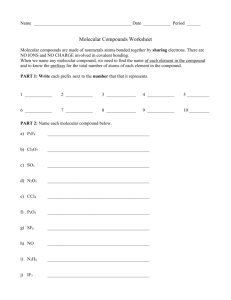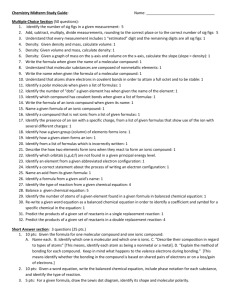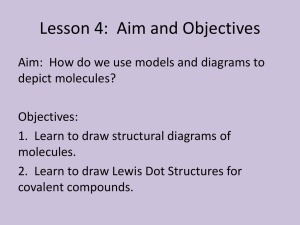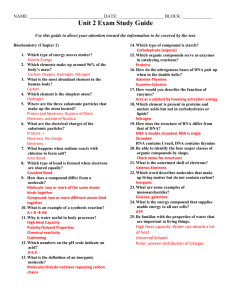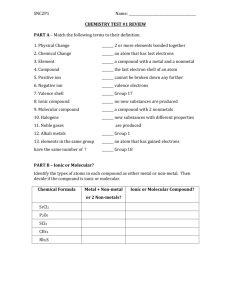Calcium Atoms Calcium Ions 2012 Lab Conclusions
advertisement
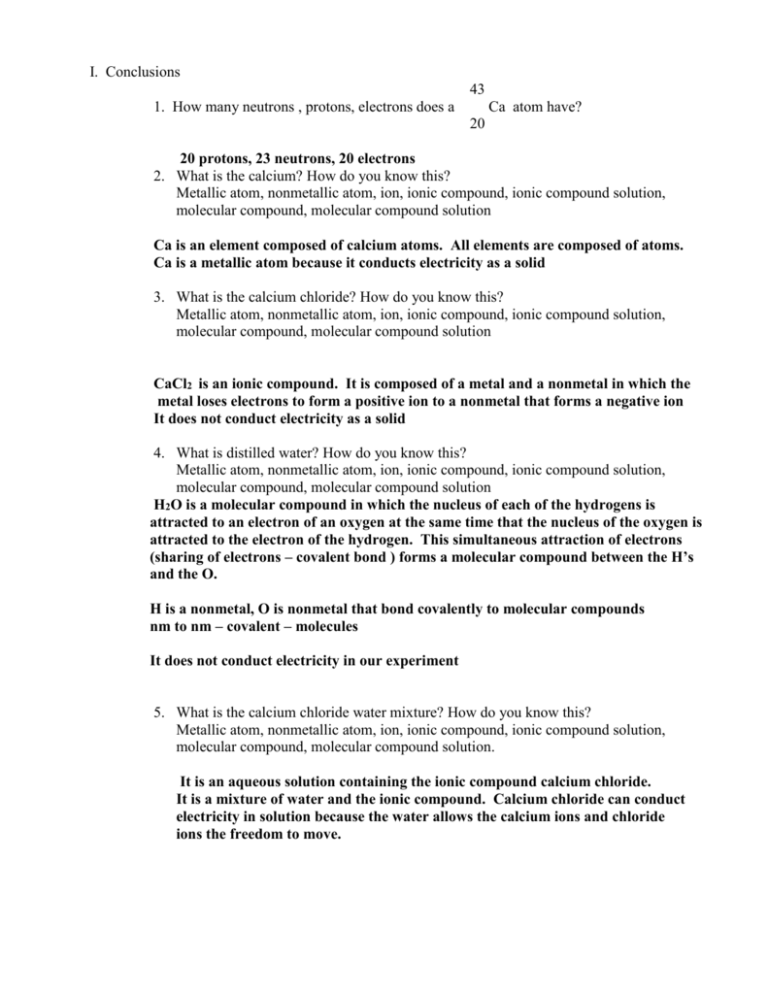
I. Conclusions 43 1. How many neutrons , protons, electrons does a Ca atom have? 20 20 protons, 23 neutrons, 20 electrons 2. What is the calcium? How do you know this? Metallic atom, nonmetallic atom, ion, ionic compound, ionic compound solution, molecular compound, molecular compound solution Ca is an element composed of calcium atoms. All elements are composed of atoms. Ca is a metallic atom because it conducts electricity as a solid 3. What is the calcium chloride? How do you know this? Metallic atom, nonmetallic atom, ion, ionic compound, ionic compound solution, molecular compound, molecular compound solution CaCl2 is an ionic compound. It is composed of a metal and a nonmetal in which the metal loses electrons to form a positive ion to a nonmetal that forms a negative ion It does not conduct electricity as a solid 4. What is distilled water? How do you know this? Metallic atom, nonmetallic atom, ion, ionic compound, ionic compound solution, molecular compound, molecular compound solution H2O is a molecular compound in which the nucleus of each of the hydrogens is attracted to an electron of an oxygen at the same time that the nucleus of the oxygen is attracted to the electron of the hydrogen. This simultaneous attraction of electrons (sharing of electrons – covalent bond ) forms a molecular compound between the H’s and the O. H is a nonmetal, O is nonmetal that bond covalently to molecular compounds nm to nm – covalent – molecules It does not conduct electricity in our experiment 5. What is the calcium chloride water mixture? How do you know this? Metallic atom, nonmetallic atom, ion, ionic compound, ionic compound solution, molecular compound, molecular compound solution. It is an aqueous solution containing the ionic compound calcium chloride. It is a mixture of water and the ionic compound. Calcium chloride can conduct electricity in solution because the water allows the calcium ions and chloride ions the freedom to move. 6. What is the sucrose? How do you know this? Metallic atom, nonmetallic atom, ion, ionic compound, ionic compound solution, molecular compound, molecular compound solution C11H22O11 is a molecular compound composed of nonmetals whose electrons are simulataneously attracted to the nucleus of a neighboring atom ( sharing of electrons - covalently bonded). Covalently bonded atoms form molecules. C is nm, H is nm, and O is a nm – covalently – molecular compounds. It does Not conduct electricity as a solid. 7. What is the sucrose water mixture? How do you know this? Metallic atom, nonmetallic atom, ion, ionic compound, ionic compound solution, molecular compound, molecular compound solution It is an aqueous solution containing a molecular compound in water. It is a mixture of water and sucrose molecules. It does Not conduct electricity when dissolved in water. 8. What is the reacted calcium water mixture? How do you know this? Metallic atom, nonmetallic atom, ion, ionic compound, ionic compound solution, molecular compound, molecular compound solution Calcium reacts with the water to form an ionic compound. Metals react with nonmetals to form ionic compounds. Water is a molecular compound composed of nonmetals. The mixture formed conducts electricity indicating the product of calcium and water is ionic. 9. What is the gas produced? How do you know this? Metallic atom, nonmetallic atom, ion, ionic compound, ionic compound solution, molecular compound, molecular compound solution The gas is hydrogen that explodes when exposed to the atmosphere and the lit splint. Hydrogen is an element composed of atoms. 10. What is the product of the gas and the gases in the atmosphere? How do you know this? Metallic atom, nonmetallic atom, ion, ionic compound, ionic compound solution, molecular compound, molecular compound solution When hydrogen explodes it reacts with oxygen to form the molecular compound water. Hydrogen and oxygen are both nonmetals and therefore bond covalently to form a molecular compound. 11. a) What is an ion? b) What is an isotope? An ion is formed when an atom or group of atoms lose or gain electrons. When they lose electrons they form positive ions and when they gain electrons they form positive ions. Isotopes are atoms of the same element that differ in the number of neutrons in their nucleus. They have the same atomic number but a different mass number. 12. How can you account for the differences in conductivity between the calcium metal, distilled water, calcium chloride, calcium chloride water mixture, sucrose, sucrose water mixture? If a substance can conduct electricity it either contains loosely held electrons or it contains mobile ions. The calcium metal contains loosely held electrons because of its relatively large atomic radius characteristic of a metal. The calcium chloride dissolved in water contains mobile ions capable of conducting electricity. The calcium chloride is an ionic compound whose ions become mobile when they dissolve in water. Ca – metal – large radius – loosely held electrons – conducts electricity CaCl2 (aq) – dissolved in water – releases mobile ions 12. a) Draw a Bohr model of a calcium atom. b) Draw a Bohr model of a chloride atom. c) Draw a Bohr model of calcium chloride. Conclusion 12 Conclusion 12 23 neutrons 20 protons 20 electrons Chlorine 17 protons 17 electrons Ca Cl Conclusion 12 Conclusion 12 +1 Cl CA -1 Cl Conclusion 12 -1 +2 Cl Cl + Ca + Cl -1 Cl Ca Cl -1 + Ca+2 Modified Bohr Model Connection to Chemical Properties Atoms will gain lose or “share” electrons in order to obtain the same number of electrons as 2He 10Ne 18Ar 36Kr 54Xe 86Rn + Cl -1 Chemical Properties Connection Quiz on Atomic Models / Light Metals will lose electrons Ca has 20 electrons, stable Ar has 18. Calcium loses 2 electrons to form a positive 2 ion Chlorine has 17 electrons, stabe Ar has 18 Chlorine gains 1 electron to from a negative 1 ion Thomsons Model Cathode Ray Experiment Charge to Mass Ratio Cathode Rays = electrons Plum Pudding Model Quiz on Atomic Models / Light Quiz on Atomic Models / Light Rutherford’s Model Gold Foil Experiment Positively charges alpha particle “bullets” Gold Foil Alpha Particle Scattering Nuclear Model Milikan Oil Droplet Experiment Electrons have a unit charge All charges must be a multiple of -1.6 x 10-19 C -1.28 x 10-18 C = 8 electrons = Possible -1.6 x 10- 19 C -1.20 x 10-18 C = 7.5 electrons= Not Possible 19 -1.6 x 10 C Quiz on Atomic Models / Light Nature of Light Bohr Model Emission Spectrum / Absorption Spectrum Quanta – Packet of Energy Photons Planetary Model 1 = 2e- , 2 = 8e-, 3=18e- , 4= 32e Maximum in each energy level Electromagnetic Radiation Can be reflected, refracted, diffracted Bounce off, bend, create interference pattern Has a velocity ( 3x108 m/s in vacuum) Has a wavelength Has a frequency C=f Nature of Light Photons, Quanta of Energy, Frequency Dependent Low Frequency Low Energy Long Wave Emission Spectrum Electron moves from a…. higher energy orbit to a lower energy orbit releasing a fixed quanta of energy or photon of light with a specific frequency and therefore specific color ( if the light is in the visible spectrum) High frequency high energy short wave Labs Conservation of Matter Mg and O Law of Definite Proportions Law of Multiple Proportions extra credit Cathode Ray Discussion Millikan Oil Droplet Discussion Rutherford’s Gold Foil Experiment Nature of Light Photons, Quanta of Energy, Frequency Dependent High Frequency High Energy Short Wave Absorption Spectrum Electron moves from a…. Lower energy orbit to a higher energy orbit absorbing a fixed quanta of energy or photon of light with a specific frequency and therefore specific color ( if the light is in the visible spectrum) Labs / Discussions Light Questions Atomic number, Mass Number, Proton discovery, Neutron Discovery, Isotopes Bohr Model Discussion Light emission Light Absorption

